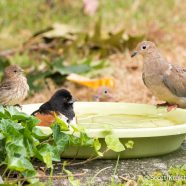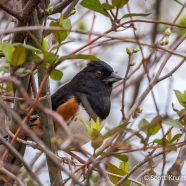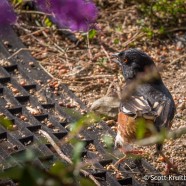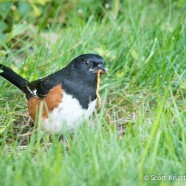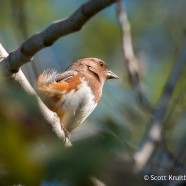Bird Baths
Here is a great example of how you do not need to break your budget while attracting birds to your yard. Putting out bird seed, suet and so forth and making a home feeding station brings in all sorts of feather friends, as can erecting nest boxes for specific species, creating a brush pile, allowing grass and flowers to grow for natural seeds and nectar, or giving them nest building materials like fur. However, even some just regularly provided clean water can do the trick, especially in times of extreme heat, drought, or frigid cold (if heated!). Here is little more than a plastic tray with...
Read MoreEastern Towhee
Have you had an Eastern Towhee in your yard yet this spring? They seem to be here, there and everywhere that they should be – feeding stations to shrubs to forest edges. This male was watching me and occasionally telling me to drink my tea. Scott Kruitbosch Conservation & Outreach Coordinator
Read MoreEastern Towhee Male
I was hiding in the shadows and bushes when photographing this male Eastern Towhee, albeit unintentionally and unexpectedly, instead of it hiding from me in the vegetation and darkness. That piercing eye still sees all! They might be dining at your house sometime this winter, if you’re lucky. Most of the time they are found at bird feeders during particularly inclement, and especially snowy, weather. We may not have much of that going on, yet, but with the temperature dropping the lake effect snow machine will be turned on again soon at least. Scott Kruitbosch Conservation &...
Read MoreTowhee Snack
This male Eastern Towhee (Pipilo erythrophthalmus) is about to scarf down a centipede snack on a recent early morning. I did not expect it to come up with that in its bill! I saw it working the ground rather hard, scratching away and pulling at the soil before revealing its prey. No, thank you, I will pass on sharing this meal. It’s all yours little guy… Scott Kruitbosch Conservation & Outreach Coordinator
Read MoreFemale Eastern Towhee
Here is the female Eastern Towhee (Pipilo erythrophthalmus) looking well after a meal (note the bits left on the bill). She is being pushed by the cool northeast winds, her brown, orange and white feathers blowing a little in the breeze. That piercing red eye is magnificent! Autumn migration is a great time to find this bird, but you may also end up seeing them in the winter – especially if one comes to seek refuge at your feeders after a major snowstorm.
Read More



